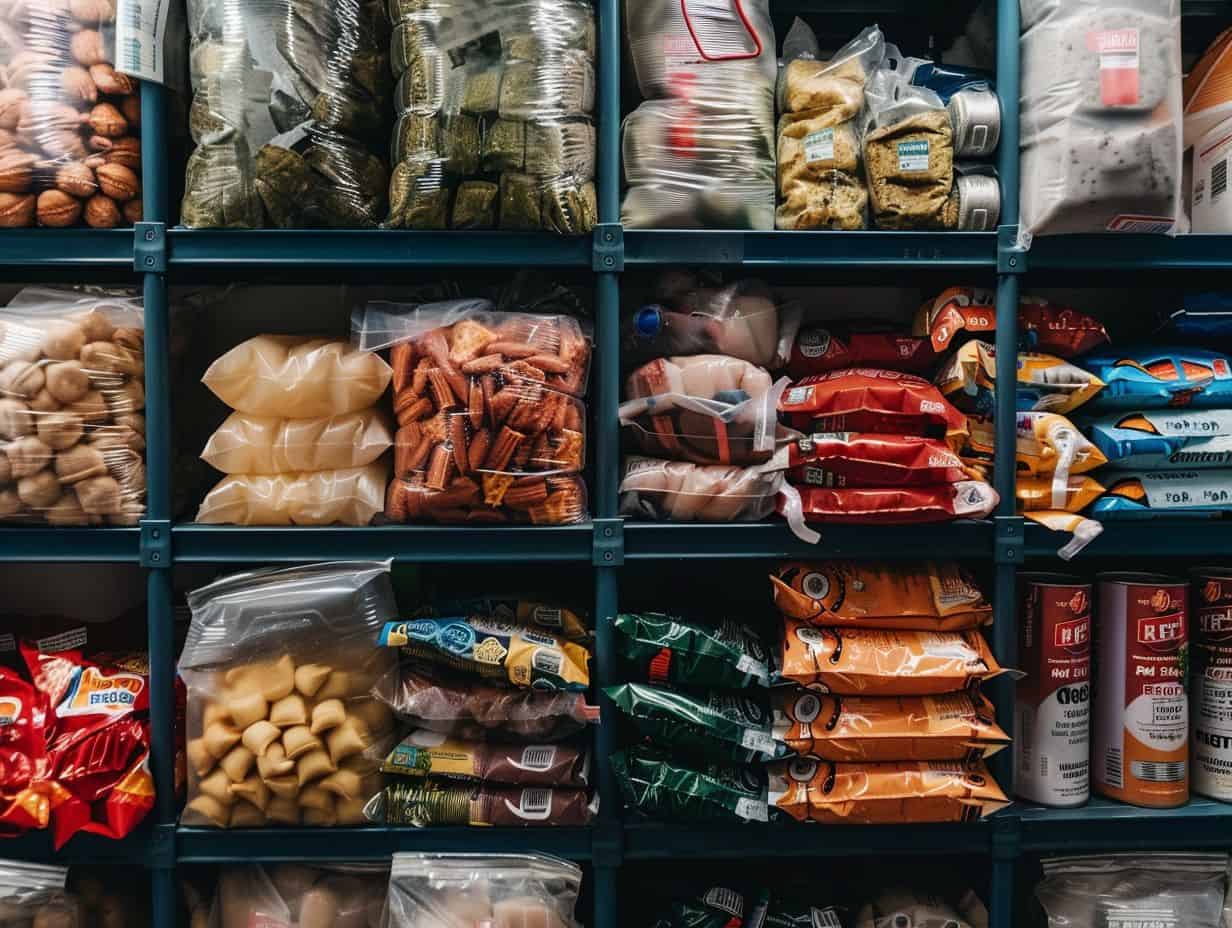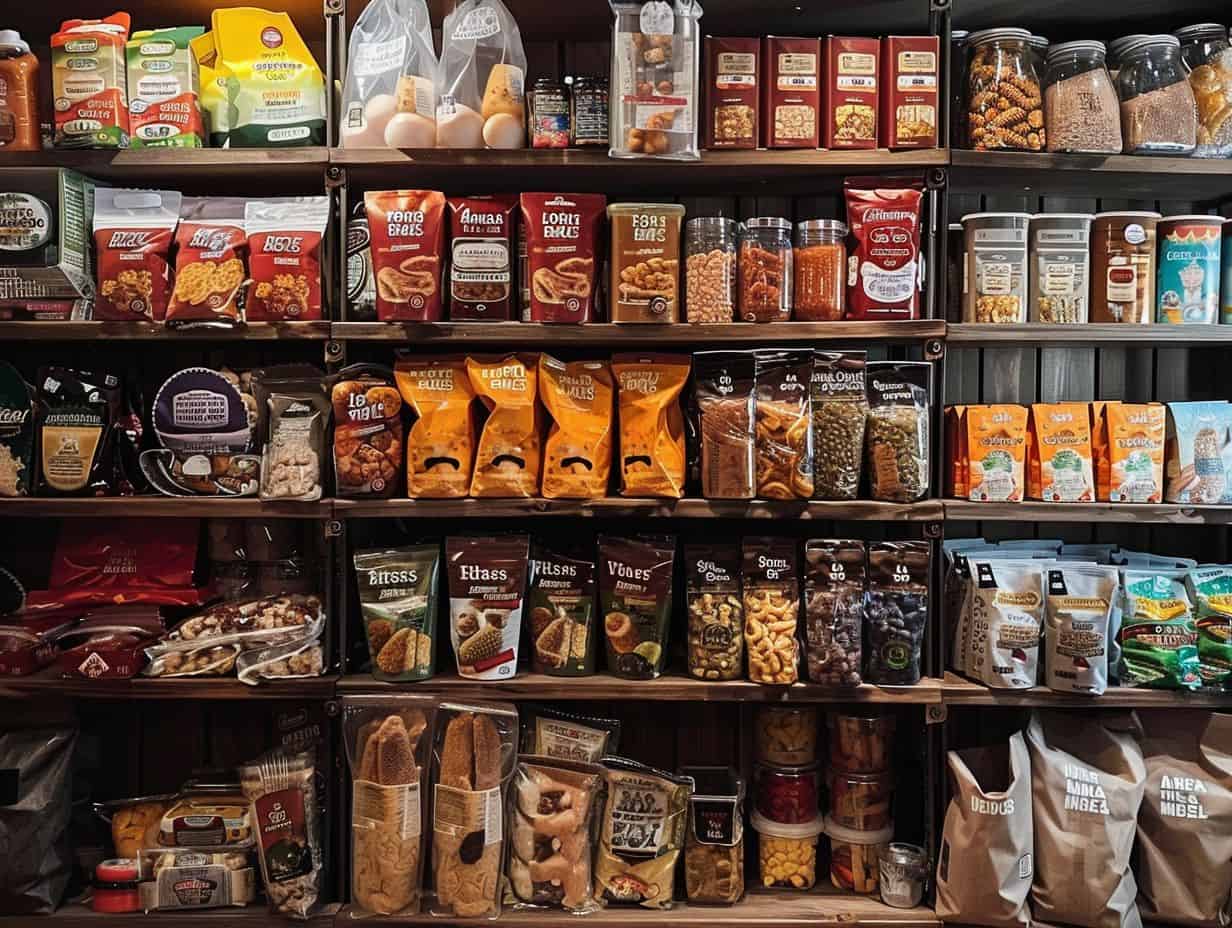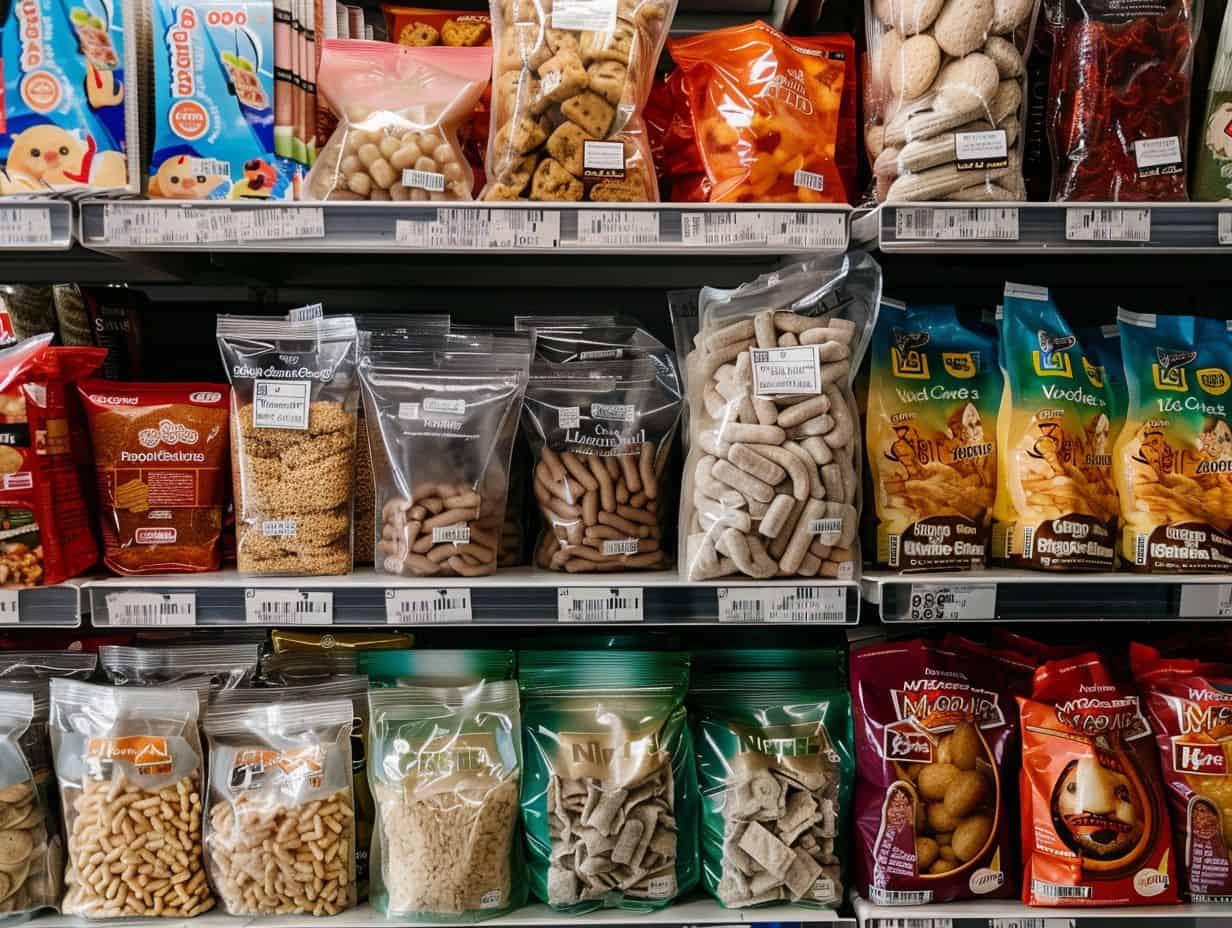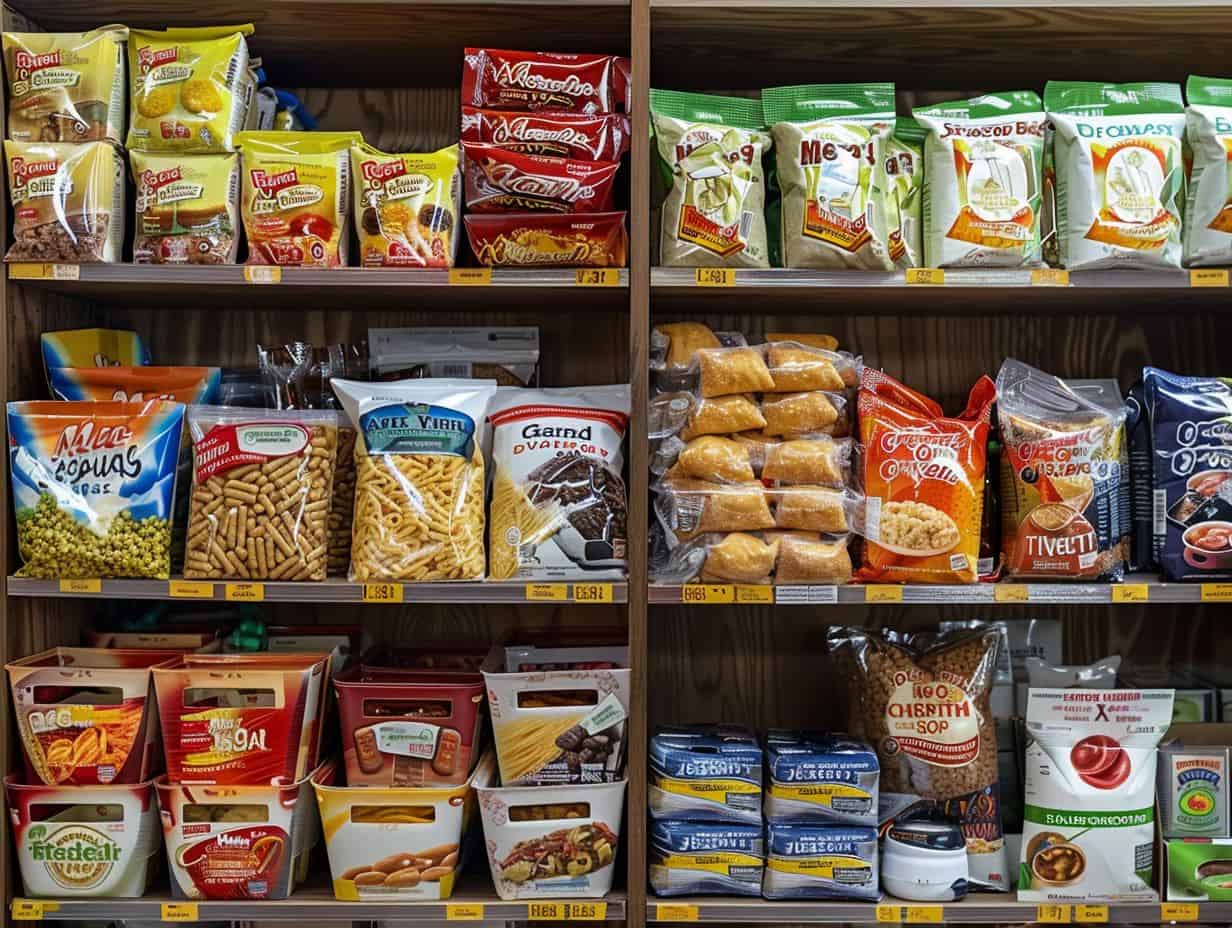Ensure the longevity of Meals Ready-to-Eat (MREs) to prevent spoilage. This article discusses the causes of spoilage in MREs and strategies to prevent it, including proper storage, the use of oxygen absorbers, and vacuum sealing.
The methods to maintain the quality of MREs will be explored. Signs of spoiled MREs and safe consumption of expired ones will be covered. Valuable tips on maximizing the lifespan of MREs will be shared.
What are MREs?
Military Ready-to-Eat (MREs) are self-contained individual meals that are commonly used by military personnel during field operations or emergencies.
These pre-packaged meals are designed to be portable, lightweight, and easy to store, making them ideal for situations where traditional cooking facilities are not available. MREs typically contain a variety of food items like main courses, sides, snacks, desserts, and even utensils for convenience. The nutritional value of MREs is carefully crafted to provide the necessary calories, proteins, carbohydrates, and vitamins needed to sustain individuals in demanding and unpredictable environments.
Whether it’s during combat missions, natural disasters, or prolonged operations, MREs play a crucial role in ensuring that soldiers and responders receive adequate nourishment to stay energized and focused.
Why is Longevity Important in MREs?
Longevity is essential in MREs to ensure that the food remains safe, nutritious, and palatable over extended periods, especially in demanding field conditions.
Proper preservation techniques play a pivotal role in maintaining the quality of MREs. Factors such as temperature control, moisture levels, and oxygen exposure need to be carefully managed to prevent the growth of harmful bacteria and preserve the food’s nutritional content.
Following recommended storage guidelines, such as keeping MREs in a cool, dry place, away from direct sunlight, can significantly prolong their shelf-life. Regularly checking the expiration dates and rotating MRE stocks ensures that personnel are always equipped with fresh and safe meals during missions and emergencies.
What Causes Spoilage in MREs?
Spoilage in MREs can occur due to various factors such as contamination by pathogens, exposure to environmental factors, or improper storage conditions.
Contamination by pathogens is a common issue that leads to the degradation of MREs, as bacteria and other harmful microorganisms can multiply and thrive in these ready-to-eat meals. Environmental factors such as temperature fluctuations, moisture, and oxygen exposure can accelerate the spoilage process.
Pathogens like Salmonella, E. coli, and Listeria pose serious health risks if consumed, ranging from food poisoning to more severe illnesses. Preventive measures such as proper sealing, refrigeration, and adherence to expiration dates are crucial in ensuring the safety and quality of MREs for consumption.
1. Oxygen Exposure
Oxygen exposure is a primary cause of spoilage in MREs as it can lead to oxidative reactions that degrade the quality of food. These reactions not only alter the taste and texture of the food but also compromise its nutritional value. To combat this, preservation techniques such as barrier protection and sealants are crucial in minimizing oxygen contact and extending the shelf life of MREs. By creating a barrier between the food and the external environment, these methods help maintain the integrity of the products. This underscores the importance of implementing proper packaging strategies in food preservation to ensure the freshness and safety of MREs for consumption.
2. Moisture Content
Moisture content is a critical factor in MRE spoilage, as an excess of moisture can facilitate microbial growth and hasten food deterioration.
Proper management of moisture content is crucial for preserving MREs to uphold their quality and safety during storage and transportation. Dehydration methods like freeze-drying or air-drying are commonly employed to efficiently eliminate moisture and prolong the shelf life of MRE products. Selecting suitable packaging materials with moisture barrier properties can assist in maintaining the desired moisture levels, thus lowering the risk of spoilage. By comprehending and implementing effective moisture control techniques, the durability and overall quality of MREs can be significantly enhanced.
3. Temperature Fluctuations
Temperature fluctuations can impact the spoilage of MREs by influencing the food’s chemical composition and speeding up microbial growth. These fluctuations create conditions that can promote the growth of harmful bacteria, posing a risk to the safety of the food. Exposure of MREs to temperatures that are too high or too low can accelerate the degradation of proteins and fats in the food, leading to changes in taste, texture, and overall quality.
To address this issue, it is important to regularly inspect and monitor storage conditions to ensure that the environment maintains the optimal temperature range. Proper control of these environmental factors is essential for preserving the shelf life of MREs and adhering to food safety standards.
How Can You Ensure Longevity in MREs?

Ensuring longevity in MREs involves proper storage practices such as the use of oxygen absorbers, vacuum sealing, and maintaining cool temperatures to extend the shelf-life of the food.
Storing MREs in a cool, dry place away from direct sunlight and extreme temperatures can effectively prevent spoilage and maintain the quality of the food.
Oxygen absorbers are important for removing oxygen from the packaging to create an environment that discourages bacteria and mold growth. Vacuum sealing complements this process by eliminating air and reducing the risk of oxidation, which could degrade the food over time.
Monitoring and controlling the temperature of the storage area is crucial to ensure that MREs remain safe for consumption over an extended period.
1. Proper Storage
Proper storage practices are crucial for maintaining the quality and safety of MREs. This includes following storage guidelines, conducting regular quality control checks, and rotating stock to prevent expired items.
This detailed approach to storage not only ensures the long-term viability of the MREs but also plays a critical role in upholding food quality standards. Quality control measures, such as monitoring temperature and humidity levels, help reduce the risk of spoilage and contamination. Stock rotation strategies are employed to ensure that older MREs are used first, minimizing waste and maximizing freshness. Adhering to storage regulations established by food safety authorities is essential to maintain the integrity of the MREs and protect consumer health.
2. Use of Oxygen Absorbers
The utilization of oxygen absorbers in MRE packaging serves to decrease oxygen levels, thus reducing the risk of contamination and preventing the growth of pathogens that may result in spoilage.
By actively absorbing surplus oxygen within the sealed packaging, these absorbers establish an environment that is unfavorable for the proliferation of harmful microorganisms. This decrease in available oxygen not only impedes the growth of aerobic bacteria and molds but also protects the food from oxidation, which can lead to rancidity and impact the taste and nutritional quality of the contents.
This uncomplicated yet efficient technology plays a critical role in improving food safety and prolonging the shelf-life of MREs, ensuring their freshness and palatability for an extended duration.
3. Vacuum Sealing
Vacuum sealing is a preservation technique commonly used in MRE packaging to eliminate air and create a sealed environment. This process helps prevent microbial growth and ensures the freshness of the food.
By removing oxygen from the MRE package, vacuum sealing effectively reduces the likelihood of oxidation, a significant factor in food spoilage. This method seals in nutrients, preserves flavors, and maintains the overall quality of the food for an extended period. Sealants are critical in maintaining an airtight package, safeguarding the contents from external contaminants.
The absence of air also hinders the proliferation of bacteria and mold, prolonging the shelf life of MREs. This makes them suitable for emergency situations or outdoor activities where access to reliable food sources is crucial.
4. Maintaining Cool Temperatures
Maintaining optimal temperatures is crucial for maximizing the efficiency of MRE storage and reducing the likelihood of food spoilage. Efficient cooling systems are vital for preserving the quality and freshness of MREs over an extended period. By ensuring that the storage environment maintains the appropriate temperature, the growth of microorganisms and chemical reactions that can affect the taste and safety of the food are effectively controlled.
Regular monitoring of storage conditions is essential to promptly address any deviations from the recommended temperature range, preserving the nutritional value and taste of the MREs. Adhering to temperature guidelines not only maintains quality but also prolongs the shelf life of the rations, ensuring they remain dependable food sources for emergencies or field operations.
What Are the Signs of Spoiled MREs?
Identifying spoiled MREs involves observing changes in appearance, smell, and texture, which can indicate contamination, deterioration, or microbial growth in the food. For example, if signs of mold, unusual discoloration, or a slimy texture are present in an MRE packet, these are strong indicators that the food inside may have spoiled. Foul or off-putting odors, such as a sour smell or a strong chemical aroma, are also red flags that the food has gone bad. If bulging or swollen packaging is detected, it’s best to discard the MRE immediately as it may have undergone bacterial contamination.
1. Changes in Appearance

Changes in appearance such as discoloration, mold growth, or bloating packaging serve as visual indicators of spoiled MREs that necessitate immediate inspection and disposal. When conducting visual checks on MREs, attention should be given to any unusual odors emitted from the packaging, as unpleasant smells can also indicate spoilage. If the packaging appears to be damaged or compromised in any way, it is advisable to err on the side of caution and refrain from consuming the contents.
When handling MREs with visual changes, it is important to use gloves to minimize direct contact and always wash hands thoroughly after disposal. Visual inspection is a critical step in ensuring the quality and safety of MREs.
2. Changes in Smell
Unusual odors, foul smells, or sour scents coming from MREs suggest contamination or spoilage, necessitating immediate disposal to mitigate health risks.
These changes in odor are critical in determining the safety of MREs. The sense of smell serves as a natural alert system, notifying individuals of potential microbial growth that may result in foodborne illnesses. Understanding how to differentiate between normal odors and those indicating spoilage can assist in avoiding consumption of harmful food. When encountering unpleasant smells in MREs, proper handling is crucial to prevent cross-contamination. Timely disposal following recommended guidelines is essential for safeguarding health and well-being.
3. Changes in Texture
Changes in texture such as sliminess, mushiness, or unusual softness in MREs can indicate spoilage caused by microbial activity or degradation of food components, signaling that the food may not be safe for consumption.
Examining the texture of MREs is important as variations can provide valuable insights into the safety and quality of the food. For example, a gritty or grainy texture could suggest ingredient crystallization or the presence of foreign particles. Similarly, a rubbery texture may indicate protein denaturation. By observing these textural changes, consumers can better determine the condition of MREs before consuming them.
When assessing MREs, it is recommended to discard any packets displaying these textural abnormalities to mitigate potential health hazards.
How Can You Safely Consume Expired MREs?
The safe consumption of expired MREs involves evaluating the food for signs of spoilage, rehydrating dehydrated components, and performing quality control checks before consuming. It is important to thoroughly examine the appearance, smell, and texture of the MRE contents before attempting to rehydrate them. Verify that the packaging is undamaged and devoid of any punctures or leaks. When rehydrating dehydrated components like freeze-dried fruits or vegetables, adhere to the instructions provided on the packaging to ensure proper hydration. Conduct a comprehensive quality control assessment by inspecting the color and consistency of the food items. Prioritize safety by exercising caution and awareness of risks when contemplating the consumption of expired MREs.
What Are the Alternatives to MREs?
Alternative options to MREs include freeze-dried meals, canned foods, and dehydrated foods, providing diverse choices for emergency or field food supplies.
These alternatives offer several advantages in different scenarios. Freeze-dried meals are lightweight and have a long shelf life, making them ideal for backpacking or camping trips. Canned foods, on the other hand, are convenient for situations where weight is not a concern, and they provide familiar meal options. Dehydrated products are great for long-term storage and can easily be rehydrated with water, making them suitable for extended emergency situations. Each option offers a unique set of benefits depending on the specific needs and conditions of the situation.
1. Freeze-dried Meals
Freeze-dried meals are lightweight and compact alternatives to MREs, offering preserved nutrition, convenience, and a variety of ingredients for quick rehydration and consumption. These meals are well-suited for outdoor activities, hiking, camping, or emergency situations because of their extended shelf life and minimal preparation requirements.
In contrast to MREs, which can be cumbersome and weighty to carry, freeze-dried meals are packaged in lightweight, space-saving containers, making them easier to transport. Freeze-dried meals typically feature a broader range of options, including savory meats and flavorful fruits and vegetables, providing a more diverse and enjoyable eating experience.
Rehydrating freeze-dried meals is a simple and rapid process, only requiring hot water to restore them to a tasty and satisfying state.
2. Canned Foods

Canned foods are durable alternatives to MREs, utilizing preservation techniques such as sterilization and sealants to ensure long-term storage and quality retention.
These preservation methods not only prolong the shelf life of canned foods but also enhance their ability to withstand various environmental conditions. The canning process is critical in preserving the nutritional value of the contents while protecting against spoilage. Due to their robust packaging, canned foods are well-suited for situations that require portability, longevity, and easy storage. The versatility of canned foods allows for a wide variety of meal options, making them a practical choice for emergency preparedness and outdoor activities.
3. Dehydrated Foods
Dehydrated foods provide lightweight alternatives to MREs. They require rehydration before consumption to restore texture and flavor while reducing the risk of pathogen growth.
The rehydration process is straightforward and effective, usually involving the addition of hot water to the dehydrated food to restore its original form. This approach not only guarantees food safety but also aids in the preservation of essential nutrients.
In emergency or field situations, the convenience of dehydrated foods is significant. They are portable, easy to store, and have a longer shelf life compared to perishable foods. This makes them well-suited for long-term storage, ensuring a secure and dependable food source when necessary.
Frequently Asked Questions
What are MREs and why is longevity important?
MREs, or Meals Ready-to-Eat, are individual packaged meals commonly used by the military and outdoor enthusiasts. These meals are designed to provide a quick and convenient source of nutrition in the field. Longevity is important for MREs because they need to remain edible and safe to consume for an extended period of time.
What are the main causes of spoilage in MREs?
The main causes of spoilage in MREs are exposure to air, heat, light, and moisture. These elements can promote the growth of bacteria and mold, leading to food spoilage and potentially making the MREs unsafe to eat.
What are some strategies for ensuring longevity in MREs?
One strategy is to store MREs in a cool, dark, and dry place. This will help prevent the growth of bacteria and extend the shelf life of the meals. Another strategy is to rotate MREs regularly, using the oldest ones first to ensure they are consumed before their expiration date.
Are there any additional steps that can be taken to battle against spoilage in MREs?
Yes, vacuum sealing individual MREs can also greatly extend their shelf life. This removes any excess air and prevents the growth of bacteria. It is also recommended to inspect MREs before consuming them, checking for any signs of spoilage such as a foul odor, discoloration, or bloating of the packaging.
How long can MREs last before spoiling?
This can vary depending on storage conditions and the specific MRE, but on average, MREs can last up to 5 years when stored properly. However, it is always important to check the expiration date on the packaging and inspect the meals before consuming them to ensure they are safe to eat.
Can MREs be frozen for extended storage?
Yes, MREs can be frozen to extend their shelf life even further. However, it is important to note that freezing can affect the texture and taste of certain components of the meal, so it may not be the best option for long-term storage. It is still recommended to rotate MREs regularly and consume them before their expiration date.


